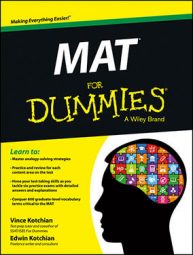Knowing how the test is structured, how to best plan your study regiment, and how to decipher and share your test results will help you earn a place in the program of your choice.
Breaking down the MAT
The MAT tests your ability to solve analogies that are constructed from a wide variety of knowledge categories. Here’s what you can expect when taking the MAT:
-
It has exactly 120 questions, covering the following categories: general knowledge, humanities, mathematics, language, natural science, and social science.
-
Of the 120 questions, only 100 go toward your actual score. The other questions are purely experimental. They are included to indicate to the test publishers if they are valid questions to include in later versions of the test. You will not know which are experimental.
-
The order of difficulty generally increases as the test progresses: The first 40 questions are easier, questions 41 to 80 are harder, and questions 81 to 120 are difficult.
-
Your score is based on how many correct answers you give. You are not penalized for skipping a question and there is no penalty for getting a question wrong.
First steps to preparing for the MAT
Excelling on the MAT requires mastery of just one type of test question: the analogy. However, the analogy will be used to test your knowledge on a wide variety of subjects. Here are a few preparation tips for tackling this test:
-
Have a baseline.
Take an official MAT practice test, which you can purchase online. Do this at the start of your test preparation to get an understanding of where you are and how far you need to improve your performance to get your ideal score.
-
Set a clear goal.
Have a defined target to keep you posted and help you measure your progress. Find out what score the program you wish to attend looks for and aim to top that.
-
Establish a practice schedule and keep to it.
Your MAT score will be a significant part of your graduate school application, so preparing for must be a priority. Carve out the time you need to brush up on or learn hundreds of terms and master analogy solving. Make it a part of your routine.
-
Take several practice tests.
There is no substitute for practicing what you’ll have to do on test day. Make sure you complete a minimum of four practice tests before taking the actual test. Keep practicing until you are satisfied with your result.
-
Work on your timing.
Learn to invest your time will it will pay off the most. Avoid wasting time on harder questions and the expense of more achievable ones.
MAT scoring and score reporting
Approximately two weeks after taking the MAT test, you will receive an Official Score Report. You will see two important scores, each of which is determined based on the number of questions you answered correctly:
-
Scaled score.
This is a standardized score based on how many answers you got right and the difficulty level of the test form. Scaled scores range from 200 to 600.
-
Percentile.
This represents the percentage of test takers earning lower than a given score. Percentiles range from 1 to 99.
There is no pass or fail score set by the publisher of the MAT. Individual colleges and universities set their own required score ranges.
Your MAT fee covers the cost of the Official Score Report and three official transcripts that are sent directly to the institutions of your choice. You must specify where you want your scores sent on testing day.

